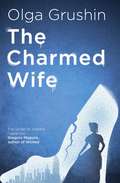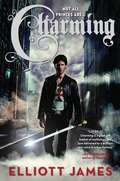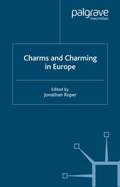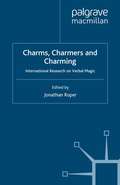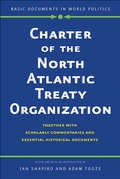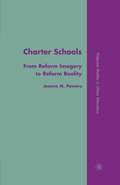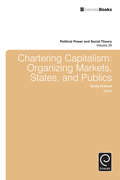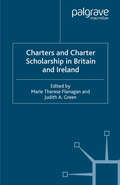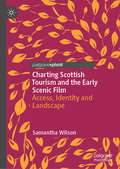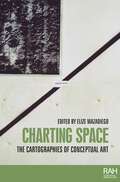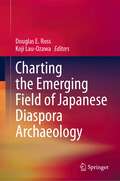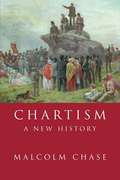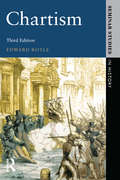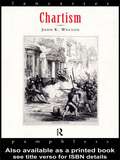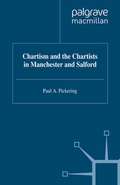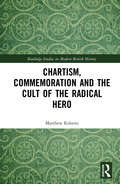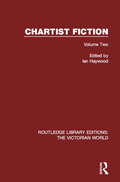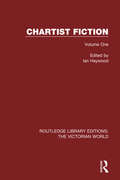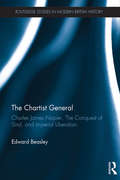- Table View
- List View
The Charmed Wife: A beautifully written, powerful reimagining that picks up thirteen years after Cinderella and Prince Charming said ‘I do’
by Olga Grushin*An Oprah Magazine Most Anticipated Book of 2021**A Woman & Home Top Four Literary Read**A lovereading.co.uk Star Book* And they lived happily ever after . . . didn't they?Cinderella married the man of her dreams - the perfect ending she deserved after diligently following all the fairy-tale rules. Yet now, two children and thirteen-and-a-half years later, things have gone badly wrong. One night, she sneaks out of the palace to get help from the Witch who, for a price, offers love potions to disgruntled housewives. But as the old hag flings the last ingredients into the cauldron, Cinderella doesn't ask for a love spell to win back her Prince Charming. Instead, she wants him dead. Endlessly surprising and wildly inventive, The Charmed Wife is a sophisticated literary fairy tale for the twenty-first century that weaves together time and place, fantasy and reality, to conjure a world unlike any other. Nothing in it is quite what it seems, and the twists and turns of its magical, dark, swiftly shifting paths take us deep into the heart of romance, marriage and the very nature of storytelling.'Dark and dreamy. Inside the plot, magic comes and goes. But inside the reader, it's all magic - all of us happily caught in Grushin's hypnotic spell.' - Karen Joy Fowler, author of We Are All Completely Beside Ourselves and The Jane Austen Book Club'Fall under its charms, I dare you' - Gregory Maguire, author of WickedA powerful, provocative and quite wonderful modern literary fairy tale. I danced through the deep dark magic of The Charmed Wife - long live the fairy tale that lives beyond "happily ever after".' - lovereading.co.uk'Surprising, darkly comedic and enchanting' - CNN'Genre-bending and darkly comic, Grushin's fourth novel is a weird and wonderful triumph.' - Oprah Magazine
Charming (Pax Arcana Ser. #1)
by Elliott JamesSharp, sarcastic, and efficiently lethal, John Charming would feel right at home having drinks with Dean Winchester and Harry Dresden. If you're looking for a new urban fantasy series to pick up, CHARMING is a guaranteed page-turner.John Charming isn't your average Prince...He comes from a line of Charmings -- an illustrious family of dragon slayers, witch-finders and killers dating back to before the fall of Rome. Trained by a modern day version of the Knights Templar, monster hunters who have updated their methods from chain mail and crossbows to Kevlar and shotguns, John Charming was one of the best--until a curse made him one of the abominations the Knights were sworn to hunt.That was a lifetime ago. Now, John tends bar under an assumed name in rural Virginia and leads a peaceful, quiet life. That is, until a vampire and a blonde walked into his bar... CHARMING is the first novel in a new urban fantasy series which gives a new twist to the Prince Charming tale. Short Fiction in the Pax Arcana world.
Charms and Charming in Europe
by J. RoperHistorical records of charms, the verbal element of vernacular magic, date back at least as far as the late middle ages, and charming has continued to be practiced until recently in most parts of Europe. And yet, the topic has received only scattered scholarly attention to date. By bringing together many of the leading authorities on charms and charming from Europe and North America, this book aims to rectify this neglect, and by presenting discussions covering a variety of periods and of locations - from Finland to France, and from Hungary to England - it forms an essential reader on the topic.
Charms, Charmers and Charming: International Research on Verbal Magic (Palgrave Historical Studies in Witchcraft and Magic)
by J. RoperBringing together many of today's key scholars of verbal charming, these essays cover vernacular magical texts and practice from Malaysia to Madagascar, and from England to Estonia. As the most comprehensive collection of research on charms, charmers and charming available in the English language, it forms an essential reader on the topic.
Charter of the North Atlantic Treaty Organization: Together with Scholarly Commentaries and Essential Historical Documents (Basic Documents in World Politics)
by Ian Shapiro Adam ToozeThe most powerful military alliance in history, NATO shaped the geopolitical contours of the Cold War and continues to structure the contemporary international system. The NATO agreement is reprinted here with speeches and essential historical documents concerning the alliance’s founding and subsequent evolution. Accompanying essays by major scholars discuss debates about NATO’s evolving governance, its role in nuclear politics, and its appropriate mission during and since the Cold War.
Charter Schools: From Reform Imagery to Reform Reality (Palgrave Studies in Urban Education)
by J. PowersThis book begins with the claims of policymakers and explores charter schools at each stage of the policymaking process, from legislation to implementation. Powers carefully and thoroughly examines how features of schools' policy contexts shape the ways that charter school reform unfolds at schools, providing a nuanced portrait of the schools participating in this much discussed and little understood reform movement. While policymakers are often prone to making sweeping claims about the efficacy of charter schools, in practice charter school reform is much more complex. By drawing on an extensive and compelling range of data, Powers assesses the validity of policymakers claims.
Chartering Capitalism: Organizing Markets, States, And Publics (Political Power and Social Theory #29)
by Emily EriksonThis volume covers the evolution of the chartered company; contributions employ comparative methods, archival research, case studies, statistical analyses, computational models, network analyses, and new theoretical conceptualizations to map out the complex interactions that took place between state and commercial actors across the globe.
Charters and Charter Scholarship in Britain and Ireland
by M. Flanagan J. GreenThis book draws together a collection of essays looking at the ways in which charters and charter scholarship in different areas of Britain and Ireland, highlighting comparisons and contrasts in charter production and use. The book shows the crucial importance of charters as sources for understanding the history of royal administration and, more broadly, the perceptions and portrayals of kingly power, as well as developments in written culture.
Charting Scottish Tourism and the Early Scenic Film: Access, Identity and Landscape
by Samantha WilsonWhat impact did walking tours and scenic films have on leisure activities? In what ways did working class travel disrupt normative narratives concerning nature and identity? The appreciation of nature and leisure travel have a complex and interrelated history in Scotland. In Charting Scottish Tourism, Wilson looks at how scenic filmmaking altered the construction of the tourist map and spatial identities at the turn of the 20th Century. Scenic film, the author argues, played a key role in the expansion of regional travel and national tourism during the period. In addition, scenic film provides the modern researcher with an unrivalled source of documentary evidence relating to the manner in which Scottish working and middle class communities explored and reclaimed the natural spaces around them. The author examines the central role of the Scottish scenic within leisure performances and the way in which these films promoted and challenged normative spatial narratives. These discursive shifts, she argues, had a wide-reaching impact on popular assumptions concerning space, nature and identity both home and away. Charting Scottish Tourism provides a fascinating case study and numerous methodological insights for students and researchers interested in documentary film as well as the construction of identity and the natural world.
Charting space: The cartographies of conceptual art (Rethinking Art's Histories)
by Elize MazadiegoBy the late 1960s cartographic formats and spatial information had become a regular feature in many conceptual artworks. This volume offers a rich study of conceptualisms’ mapping practices that includes more expanded forms of spatial representation.The book presents twelve in-depth case studies that address artists’ engagement with matters of space at a time when space was garnering new significance in art, theory and culture. The chapters shed fresh light on an evident ‘spatial turn’ that took place from the postwar to the contemporary period, revealing how it was influenced by larger historical, social and cultural contexts.In addition to raising questions about conceptualism’s relationship to the world, the contributors illustrate how artists’ cartographies served as critical sites for formulating their politics, upsetting prevailing systems and graphing new, heterogenous spaces.
Charting space: The cartographies of conceptual art (Rethinking Art's Histories)
by Elize MazadiegoBy the late 1960s cartographic formats and spatial information had become a regular feature in many conceptual artworks. This volume offers a rich study of conceptualisms’ mapping practices that includes more expanded forms of spatial representation.The book presents twelve in-depth case studies that address artists’ engagement with matters of space at a time when space was garnering new significance in art, theory and culture. The chapters shed fresh light on an evident ‘spatial turn’ that took place from the postwar to the contemporary period, revealing how it was influenced by larger historical, social and cultural contexts.In addition to raising questions about conceptualism’s relationship to the world, the contributors illustrate how artists’ cartographies served as critical sites for formulating their politics, upsetting prevailing systems and graphing new, heterogenous spaces.
Charting the Emerging Field of Japanese Diaspora Archaeology
This book examines the Japanese diaspora from the historical archaeology perspective—drawing from archaeological data, archival research, and often oral history—and explores current trends in archaeological scholarship while also looking at new methodological and theoretical directions. The chapters include research on pre-War rural labor camps or villages in the US, as well as research on western Canada (British Columbia), Peru, and the Pacific Islands (Hawai‘i and Tinian), incorporating work on understudied urban and cemetery sites. One of the main themes explored in the book is patterns of cultural persistence and change, whether couched in terms of maintenance of tradition, “Americanization,” or the formation of dual identities. Other themes emerging from these chapters include consumption, agency, stylistic analysis, community lifecycles, social networks, diaspora and transnationalism, gender, and sexuality. Also included are discussions of trauma, racialization, displacement, labor, heritage, and community engagement. Some are presented as fully formed interpretive frameworks with substantial supporting data, while others are works in progress or tentative attempts to push the boundaries of our field into innovative new territory. This book is of interest to students and researchers in historical archaeology, anthropology, sociology of migration, diaspora studies and historiography.Previously published in International Journal of Historical Archaeology Volume 25, issue 3, September 2021
Chartism: A new history
by Malcolm ChaseChartism, the mass movement for democratic rights, dominated British domestic politics in the late 1830s and 1840s. It mobilised over three million supporters at its height. Few modern European social movements, certainly in Britain, have captured the attention of posterity to quite the extent it has done. Encompassing moments of great drama, it is one of the very rare points in British history where it is legitimate to speculate how close the country came to revolution. It is also pivotal to debates around continuity and change in Victorian Britain, gender, language and identity. Chartism: A New History is the only book to offer in-depth coverage of the entire chronological spread (1838-58) of this pivotal movement and to consider its rich and varied history in full. Based throughout on original research (including newly discovered material) this is a vivid and compelling narrative of a movement which mobilised three million people at its height. The author deftly intertwines analysis and narrative, interspersing his chapters with short ‘Chartist Lives’, relating the intimate and personal to the realm of the social and political. This book will become essential reading for anyone with an interest in early Victorian Britain, specialists, students and general readers alike.
Chartism
by Edward Royle Roger LockyerThis text has established itself as the best short account of the Chartist movement available. It considers its origins and development, placing the movement within its broad social and economic context. Dr Royle also provides clear analysis of its strategy and leadership and assesses the conflicting interpretations for the failure of Chartism.
Chartism
by Edward Royle Roger LockyerThis text has established itself as the best short account of the Chartist movement available. It considers its origins and development, placing the movement within its broad social and economic context. Dr Royle also provides clear analysis of its strategy and leadership and assesses the conflicting interpretations for the failure of Chartism.
Chartism
by John WaltonChartism is an essential introduction to the movement, and examines the controversial debates surrounding the topic. As well as providing a concise period background, the author includes discussion of:* the Chartists' economic, legislative and political goals* patterns of regional and local support* reasons for the Chartist decline* the success of Chartism in the light of its goals and its influence over the Poor Law, Corn Laws, trade unions and factory reform* the languages of Chartism - songs, gesture and propaganda.
Chartism
by John WaltonChartism is an essential introduction to the movement, and examines the controversial debates surrounding the topic. As well as providing a concise period background, the author includes discussion of:* the Chartists' economic, legislative and political goals* patterns of regional and local support* reasons for the Chartist decline* the success of Chartism in the light of its goals and its influence over the Poor Law, Corn Laws, trade unions and factory reform* the languages of Chartism - songs, gesture and propaganda.
Chartism and the Chartists in Manchester and Salford
by P. PickeringIn 1845 Frederick Engels wrote that 'Manchester is the seat of the most powerful unions, the central point of Chartism, the place which numbers the most Socialists'. There have been many local studies of the Chartist struggle for democratic political reform, but there is no major study of the movement in the Manchester-Salford conurbation, its most important provincial centre. This book brings an innovative approach to an exploration of aspects of the Chartist experience in the 'shock city' of the industrial revolution.
Chartism, Commemoration and the Cult of the Radical Hero (Routledge Studies in Modern British History)
by Matthew RobertsChartism, the British mass movement for democratic and social rights in the 1830s and 1840s, was profoundly shaped by the radical tradition from which it emerged. Yet, little attention has been paid to how Chartists saw themselves in relation to this diverse radical tradition or to the ways in which they invented their own tradition. Paine, Cobbett and other ‘founding fathers’, dead and alive, were used and in some cases abused by Chartists in their own attempts to invent a radical tradition. By drawing on new and exciting work in the fields of visual and material culture; cultures of heroism, memory and commemoration; critical heritage studies; and the history of political thought, this book explores the complex cultural work that radical heroes were made to perform.
Chartism, Commemoration and the Cult of the Radical Hero (Routledge Studies in Modern British History)
by Matthew RobertsChartism, the British mass movement for democratic and social rights in the 1830s and 1840s, was profoundly shaped by the radical tradition from which it emerged. Yet, little attention has been paid to how Chartists saw themselves in relation to this diverse radical tradition or to the ways in which they invented their own tradition. Paine, Cobbett and other ‘founding fathers’, dead and alive, were used and in some cases abused by Chartists in their own attempts to invent a radical tradition. By drawing on new and exciting work in the fields of visual and material culture; cultures of heroism, memory and commemoration; critical heritage studies; and the history of political thought, this book explores the complex cultural work that radical heroes were made to perform.
Chartist Fiction: Volume Two (Routledge Library Editions: The Victorian World)
by Ian HaywoodFirst published in 2001. When the Chartist leader Ernest Jones emerged from prison in 1850, he was determined to capture the public’s attention with a controversial and topical novel. The result of his endeavours was the remarkable Woman’s Wrongs, a series of five tales exploring women’s oppression at every level of society from the working class to the aristocracy. Each story presents a graphic, often harrowing account of the social, economic and emotional victimization of women, and taken together the tales comprise a devastating indictment of Victorian patriarchal attitudes and sexual inequalities. In his substantial Introduction, Ian Haywood places the novel in the context of Jones’s career as a Chartist author and editor, and in the wider context of the ‘woman question’. Some of the topics covered by the Introduction include: the radical press and popular enlightenment, Jones’s rivalry with George W. M. Reynolds, and the needlewoman as radical icon. This title will be of interest to students of history.
Chartist Fiction: Volume Two (Routledge Library Editions: The Victorian World)
by Ian HaywoodFirst published in 2001. When the Chartist leader Ernest Jones emerged from prison in 1850, he was determined to capture the public’s attention with a controversial and topical novel. The result of his endeavours was the remarkable Woman’s Wrongs, a series of five tales exploring women’s oppression at every level of society from the working class to the aristocracy. Each story presents a graphic, often harrowing account of the social, economic and emotional victimization of women, and taken together the tales comprise a devastating indictment of Victorian patriarchal attitudes and sexual inequalities. In his substantial Introduction, Ian Haywood places the novel in the context of Jones’s career as a Chartist author and editor, and in the wider context of the ‘woman question’. Some of the topics covered by the Introduction include: the radical press and popular enlightenment, Jones’s rivalry with George W. M. Reynolds, and the needlewoman as radical icon. This title will be of interest to students of history.
Chartist Fiction: Volume One (Routledge Library Editions: The Victorian World)
by Ian HaywoodFirst published in 1999. For the first time since their appearance in Chartist newspapers these two major radical narratives are reprinted in a single volume. The Political Pilgrim’s Progress combines Utopian politics with Bunyanesque satire to tell the story of the journey of Radical and his family from the City of Plunder to the City of Reform. Sunshine and Shadow is the only serialized novel to have been published in the Northern Star. It brings together fictional biography and historical chronicle to form the first truly working-class novel. Both texts offer a unique insight into the literary achievements of the Chartist movement, and will be a valuable and entertaining source for scholars of radical politics. The texts are fully annotated, and the editor also provides an introduction to each story and a bibliography of recent scholarship.
Chartist Fiction: Volume One (Routledge Library Editions: The Victorian World)
by Ian HaywoodFirst published in 1999. For the first time since their appearance in Chartist newspapers these two major radical narratives are reprinted in a single volume. The Political Pilgrim’s Progress combines Utopian politics with Bunyanesque satire to tell the story of the journey of Radical and his family from the City of Plunder to the City of Reform. Sunshine and Shadow is the only serialized novel to have been published in the Northern Star. It brings together fictional biography and historical chronicle to form the first truly working-class novel. Both texts offer a unique insight into the literary achievements of the Chartist movement, and will be a valuable and entertaining source for scholars of radical politics. The texts are fully annotated, and the editor also provides an introduction to each story and a bibliography of recent scholarship.
The Chartist General: Charles James Napier, The Conquest of Sind, and Imperial Liberalism (Routledge Studies in Modern British History)
by Edward BeasleyGeneral Charles James Napier was sent to confront the tens of thousands of Chartist protestors marching through the cities of the North of England in the late 1830s. A well-known leftist who agreed with the Chartist demands for democracy, Napier managed to keep the peace. In South Asia, the same man would later provoke a war and conquer Sind. In this first-ever scholarly biography of Napier, Edward Beasley asks how the conventional depictions of the man as a peacemaker in England and a warmonger in Asia can be reconciled. Employing deep archival research and close readings of Napier's published books (ignored by prior scholars), this well-written volume demonstrates that Napier was a liberal imperialist who believed that if freedom was right for the people of England it was right for the people of Sind -- even if "freedom" had to be imposed by military force. Napier also confronted the messy aftermath of Western conquest, carrying out nation-building with mixed success, trying to end the honour killing of women, and eventually discovering the limits of imperial interference.
